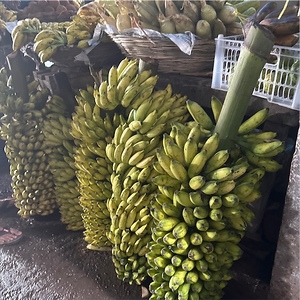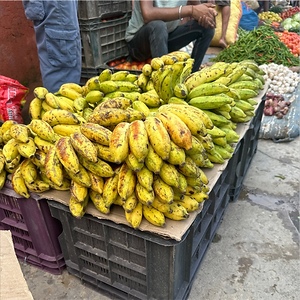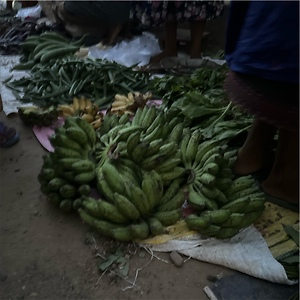


Chini Champa Bananas
Estimated Inventory, bunch : 0
Description/Taste
Chini Champa bananas are a small varietal, averaging 10 to 13 centimeters in length, and have a short, plump, curved, and cylindrical shape, tapering to a small, pointed tip on the non-stem end. The fruits form in tightly clustered bunches, and each banana has a thin, rubbery, smooth, and easy-to-peel surface. The peel is delicate and often bruised due to its thin nature, showcasing brown markings and spots from cultivation damage and handling. The peel also ripens from bright green to a vibrant golden yellow with maturity. Underneath the surface, the ivory to pale yellow flesh is solid, dense, semi-firm, and creamy with a silky but substantial, soft, and chewy texture. Some of the fruits may also have tiny, black, underdeveloped seeds that are unnoticeable when eaten. Chini Champa bananas release a sweet and sour aroma, and the flesh is edible raw with a sweet, subtly acidic, and tangy taste.
Seasons/Availability
Chini Champa bananas are available year-round.
Current Facts
Chini Champa bananas, botanically a part of the Musa genus, are a triploid AAB cultivar belonging to the Musaceae family. The small, thick fruits grow in heavy and dense, medium to large bunches on plants reaching 4 to 5 meters in height and are native to India, where they are commercially cultivated as a fresh eating variety. The name Chini Champa roughly translates to “sweet fragrance,” and the variety earned this moniker for its sweet, aromatic nature. Chini Champa bananas are cold-tolerant, resistant to some diseases, and grown as a dessert variety. Each hand produces 15 to 16 fingers, and the cultivar also develops red midribs, stems, and shoots, making them a popular ornamental in home gardens. Chini Champa bananas are savored for their sweet and tangy taste, and the fruits are also incorporated into a wide array of raw and cooked culinary preparations.
Nutritional Value
Chini Champa bananas are a source of vitamin C to strengthen the immune system while reducing inflammation, potassium to balance fluid levels within the body, fiber to regulate the digestive tract, and vitamin A to maintain healthy organ functioning. The fruits also provide calcium to build strong bones and teeth, iron to develop the protein hemoglobin for oxygen transport through the bloodstream, vitamin E to reduce inflammation, magnesium to control nerve functioning, and other nutrients, including manganese, zinc, phosphorus, riboflavin, niacin, copper, folate, and vitamin K.
Applications
Chini Champa bananas have a sweet and tangy taste suited for fresh and cooked preparations. The variety is traditionally consumed straight out of hand and is valued as a snack or healthy dessert. Chini Champa bananas can be peeled and eaten when ripe, and the fruits are mostly consumed raw in India. The variety can also be sliced into fruit salads, blended into smoothies, or served as a topping over parfaits and breakfast dishes. In addition to slicing and serving, Chini Champa bananas can be pureed and frozen into sorbets and ice cream. The fruits can also be mixed into puddings, custards, mousses, baked into bread, or simmered in spices, butter, or sugar to create a caramelized dessert. In Northeastern India, Chini Champa bananas are fried, sliced and served in a banana soup with tapioca, or added to sweet desserts such as banana coconut halwa. Chini Champa bananas pair well with other fruits such as pineapples, mangoes, papayas, spices including cinnamon, cardamom, nutmeg, ginger, vanilla, maple syrup, and brown sugar. Whole Chini Champa bananas should be stored at room temperature in a cool, dark place away from direct sunlight to ripen. It can take several days for the bananas to mature, and once ripe, the fruits will retain a firm consistency for 1 to 2 weeks after ripening. Chini Champa bananas can also be frozen or dried for extended use.
Ethnic/Cultural Info
Chini Champa bananas are notably used in koat pitha, a dessert made of bananas fried in a dough with jaggery. Koat pitha is a traditional dessert of Arunachal Pradesh, and the recipe spread throughout northeastern India as a dish served as a special occasion. Pitha, in general, is thought to have been developed in the Indian subcontinent, and various items are dipped into a dough or batter and then fried. The sweet and savory dish has many variations, including koat pitha, and is served at household dinner parties, weddings, celebratory gatherings, and festivals. Pitha is especially popular in Bangladesh, and the practice of making the dish dates back thousands of years. Chini Champa bananas are favored for koat pitha as the flesh has a sweet and tangy flavor, balancing the rich elements in the batter. The bananas are also small, making them easy to use in preparations.
Geography/History
Chini Champa bananas are native to India and have been growing wild since ancient times. The variety has been carried with migrating peoples and merchants to tropical and subtropical regions throughout Southern and Southeastern Asia, and the plants thrive in shaded areas, woodlands, and forest edges. Chini Champa bananas are commercially cultivated in the Indian states of West Bengal, Arunachal Pradesh, Meghalaya, Tripura, Assam, and Nagaland, and the variety is also grown in Bhutan. Outside of Asia, Chini Champa bananas are offered through specialty retailers in Canada for planting as a novelty in gardens. Today, Chini Champa bananas are primarily grown in India and Bhutan and are sold through fresh markets, roadside stands, and select grocers. The Chini Champa bananas featured in the photograph above were sourced through a local market in Dimapur, a city in the state of Nagaland in India.
Recipe Ideas
Recipes that include Chini Champa Bananas. One
| Global Kitchen Travels |
|
Nagaland Banana Fritters- Koat Pitha |
| Travel By Stove |
|
Sweet Banana Soup With Tapioca |










